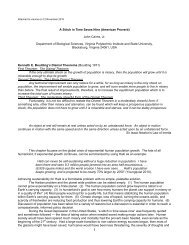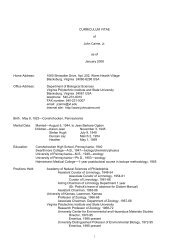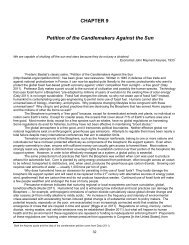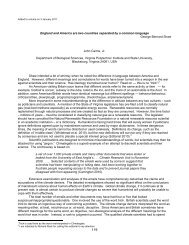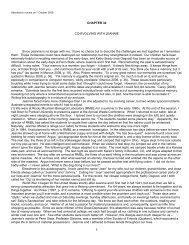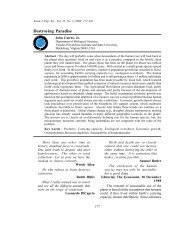View - ResearchGate
View - ResearchGate
View - ResearchGate
Create successful ePaper yourself
Turn your PDF publications into a flip-book with our unique Google optimized e-Paper software.
260Cairns: Eco-Ethics and Sustainability Ethicsregarded as synonymous with growth). Development is just one metric valued by one species. Sustainabilityinvolves a variety of metrics for a complex, multivariate living system called the interdependentweb of life.Sustainability is the study of patterns involving all forms of life and the conditions necessary forthem to flourish as a community. One can place an infinite value on human life and on other lifeforms as well. One can place an infinite value on one’s own life but be willing to sacrifice it to protectone’s offspring. This example illustrates that there can be more than one value for infinity. Sustainabilityinvolves a similar situation — humankind must place infinite value on personal life, on thelives of its future generations, and on those of other life forms. Balancing these seemingly incompatiblevalues will never be fully achieved since life consists of dynamic and stochastic events thatwill frequently alter the factors affecting this precarious balance. Sustainability policies may bedeveloped for individual components (e.g. agriculture, transportation, energy, communities, fisheries),but achieving sustainability will not be possible unless the policies are integrated into a masterpolicy and plan that does not adversely affect other components. Numeracy will be helpful inestablishing component balancing.USING AVAILABLE NUMERICAL DATANumbers influencing sustainability are simple and straightforward but are either ignored ormisunderstood by policy makers and the general public. As a consequence, unethical and unsustainablepractices and behaviors are termed ‘practical,’ ‘essential,’ ‘good for the economy,’‘compassionate,’ and even ‘religious.’ Arguably, the greatest threat to sustainability is the misinformationon the dangers of human population growth (Bartlett 1998). As Bartlett (1998) notes, themore optimistic the prediction the greater the probability that the prediction is based on faulty arithmeticor no arithmetic at all. The human population cannot continue to grow exponentially andindefinitely on a finite planet. The debate on population growth began over 200 years ago withMalthus’ (1798) insightful publication. At the root of this controversy is the denial of limits. Hardin(1993) provides a superb illustration (starting with a single lily pad of a specific size in a pond of aspecific size and a specific rate of increase) of how rapidly a limit can be reached when exponentialgrowth occurs even when no problem is apparent at present. This illustration could be appliedto a population of any species on the planet — including humans. When will the pond be coveredwith lily pads? Assuming a daily doubling rate, the capacity will be reached on the 30th day. However,the pond would only be half covered on the 29th day. Seeking new resources will not avertreaching the limits since doubling the size of the pond will only postpone saturation (i.e. reachingthe capacity) for one day; quadrupling the size of the pond would only add two days. In short, allappears well until the final doubling. After the 30th day, the lily pads produced would suffer seriouslydue to lack of space. Clearly, other life forms in the pond would also suffer at this stage. Emotionalreasons that could lead to refusal to accept this reality for populations of humans mayultimately cost billions of lives.This important issue of exponential growth can be examined by anyone with a pocket calculatoror a pencil and a sheet of paper. For example, starting with one of anything, ten doublings willproduce the astonishing number of 512. An estimate of doubling time can be calculated by dividingthe growth rate into 70. A 2 % population growth rate per year (considered modest thesedays) results in a doubling time of 35 years. An island with a carrying capacity of 256 peoplewould be in deep trouble with a single doubling. By ignoring simple numbers, humankind placesitself at great risk.





